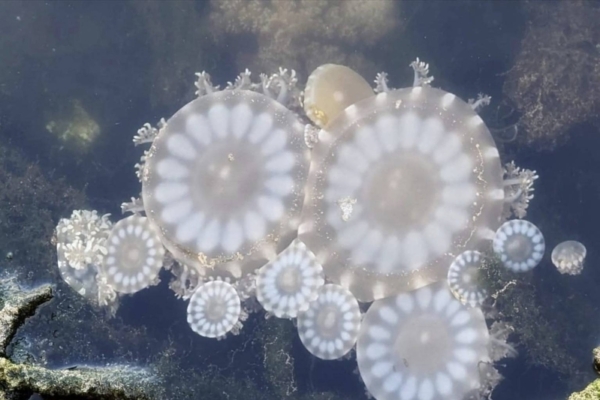In Kaohsiung, there is the only “Jellyfish Lake” in Taiwan, located in the Lin Yuan Marine Wetland Park. The photographer, Song Yongtai, stated that the Jellyfish Lake Park in Taiwan experienced a massive jellyfish outbreak starting from early December 2024, with approximately 60,000 jellyfish appearing. He described the jellyfish resembling cherry blossoms, creating a beautiful sight, and estimated that after the Lunar New Year in 2025, the jellyfish population could reach between 80,000 to 100,000.
According to Song Yongtai, the photographer, there are newly completed art installations in the Jellyfish Lake Park in Taiwan. He mentioned that from early December 2024, he noticed a sudden surge in the jellyfish population. Based on his observation over the years, he predicted that this year would be a year of massive jellyfish outbreak. He believed that currently there are around 60,000 jellyfish, and he anticipated that post-New Year, the jellyfish would gather densely, possibly reaching up to 100,000 individuals.
On January 3rd, Song Yongtai coincidentally encountered Fengxiang Junior High School students conducting outdoor ecological education at the Marine Wetland Park and took a group photo with them. He also met with Taiwan Power Company photography class students on-site, engaging in eco-experiences and capturing the jellyfish ecology through photography.
Song Yongtai mentioned that the mangroves in the Jellyfish Lake Park were flourishing, making it challenging to observe the underwater jellyfish ecology. However, in early October last year, a powerful typhoon named Santou hit Taiwan, causing significant damage to the dense branches of the mangrove forest. This led to the mangroves appearing sparser, improving the observation spaces and visibility for studying the jellyfish. Consequently, a few more observation points were added to the Jellyfish Lake, making it easier for the public to appreciate the jellyfish ecology up close.
The “Cassiopea Jellyfish,” also known as the “Upside-Down Jellyfish,” is a common species in the area. Song Yongtai explained that larger jellyfish can be as big as a bowl, while newborn jellyfish are as small as a fingernail.
Song Yongtai documented the onsite ecology of the wetland park, where visitors can observe various bird species such as kingfishers, swamphens, night herons, pond herons, great egrets, cattle egrets, Chinese pond herons, purple herons, and striated herons. He emphasized that the ecology of the Jellyfish Lake is rich and welcoming, inviting people to visit with their families during the Lunar New Year.

